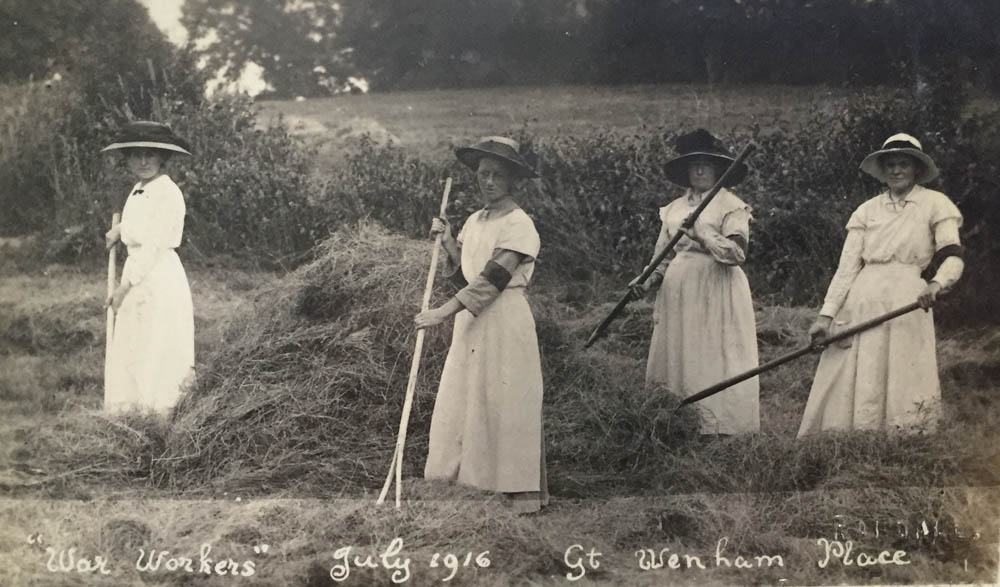Before the the government set up the Women’s Land Army in 1917, several organisations employed women as farm workers. This page shares details on some of these organisations.
Women’s Defence Relief Corps (WDRC) – formed 9th September 1914
- Relieve defenders so women could undertake any work which would set free a man for the fighting line and secondarily to induce women to prepare for whatever might be coming by making themselves practically efficient
- Non-political, non-sectarian and democratic organisation
- Sent out ‘bands of women to work at haymaking, harvesting, market-gardening and fruit-picking’
- Advertised as a free holiday for women to work on the land
- Majority were Londoners
- At its peak (1916 & 1917), it placed 500 women on the land
- Received £50 grant from Board of Agriculture in January 1917
Women’s Legion – formed December 1914
- Formed an Agricultural Section
- This aimed to further the employment of women in agriculture
- Received annual grant of £200 from the Board of Agriculture
- Concluded that it was expensive to run in comparison with results achieved
National Political League (NPL) – formed 1911
- Main objective was to further social and political reforms on a non-party basis
- Formed Land Council shortly after outbreak of war
- Sought to help professional middle-class women (and men – especially disabled soldiers and sailors) to find suitable work on the land and to further other social reforms
- Since the outbreak of war, 2,000 women had registered
- It had previously received grant from the Board of Agriculture, but it was stopped like for the Women’s Legion
- Like Women’s Legion, it was perceived to be inefficient and of little practical value
Women’s Farm and Garden Union (WFGU) – formed 1899
- Valuable work before the war looking after interests of all professional workers in agriculture, horticulture and allied field through offering training courses and placing women on the land
- Launched an experimental practical training course for educating women – lasted for 12 weeks and covered all forms of farm work
- Experiment demonstrated that women could, after a short period of training, play a crucial role on the land
- By September 1916, nearly 800 women trained under auspices of WFGU and WNLSC (see below) had been placed on land as permanent workers. There was an additional 1321 women who had been placed on the land, either as permanent workers with previous experience and therefore not requiring training, or as untrained workers in gangs.
Women’s National Land Service Corps (WNLSC) – formed February 1916
- Deputation from WFGU met with Lord Selbourne (President of the Board of Agriculture) and as a result of negotiations with Board of Agriculture, an initial grant of £150 was made for the Union to organise the training of women
- Formed under direction of Mrs Louise Wilkins
- Offshoot of the WFGU
- Dealt with problem of emergency war work as opposed to permanent employment
- Objectives were:
- Speed up recruitment of all classes
- Create a favourable opinion as to the value of women’s work in agriculture by supplying a body of workers capable of making a good impression
- Use members of the Corps, not only as units of labour, but as organisers of the work of village women
- Help in work of general propaganda; supplying County Committees with organisers and trained speakers
- By end of year, had recruited 2,000 volunteers, mostly middle-class women from urban districts
- Aimed that these women would be shining examples for rural women in local villages in emulate
- Sought to recruit the ‘right type of women’ who ‘would create a favourable impression on the farming community’
- Candidates outside of London were interviewed by members of the Head Mistresses’ Association
- Wanted young, strong, healthy, educated women fond of animals and outdoor life
- By end of 1916, demands placed on WNLSC were greater than it could possibly meet
- It was estimated that an additional 40,000 full-time female workers were needed
- In December 1916, it was then suggested to set up the Women’s Land Army
- In April 1917, the WNLSC circulated information on the new Women’s Land Army to all of its members (900 at that time).
- 530 replied
- 88 joined the Women’s Land Army
- It was from their ranks that Group Leaders for the Women’s Land Army were being drawn
- Many of these pioneer members were also appointed as superintendents of new training centres
For more information on the formation of the Women’s Land Army, please click here.
Information summarised from ‘The Women’s Land Army: A Portrait’ by Gill Clarke

Source: Catherine Procter Collection